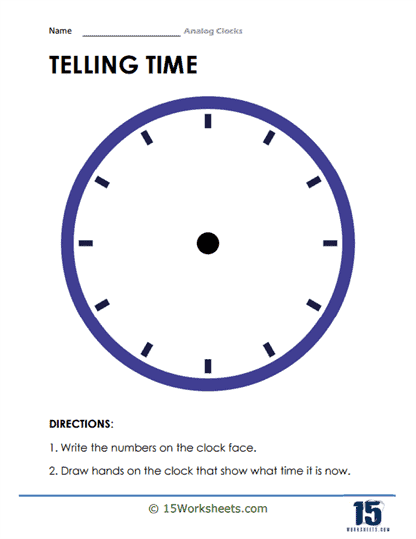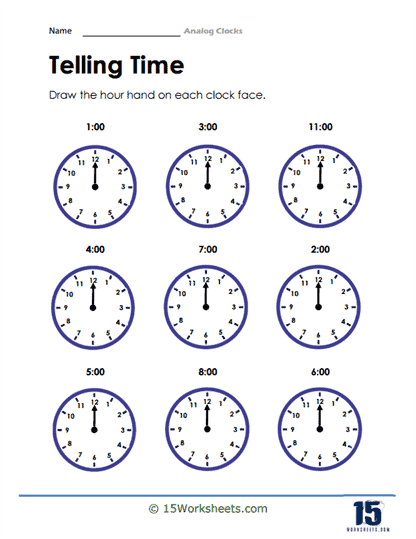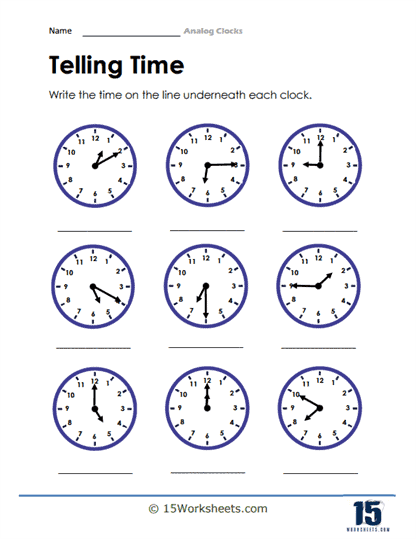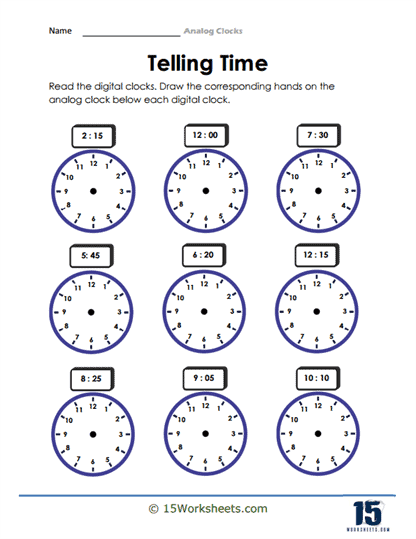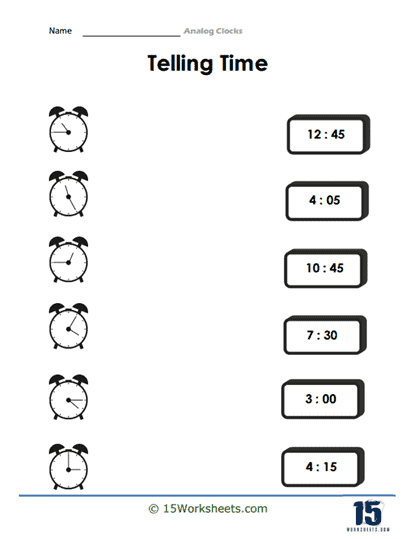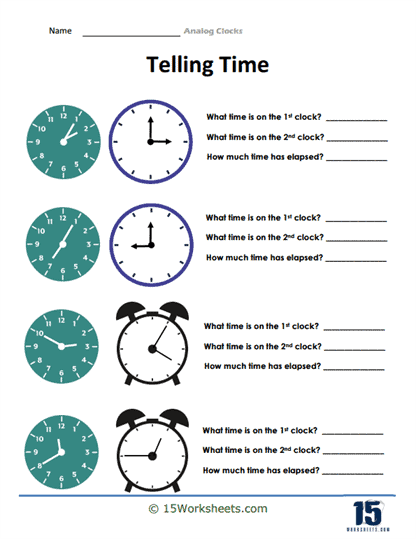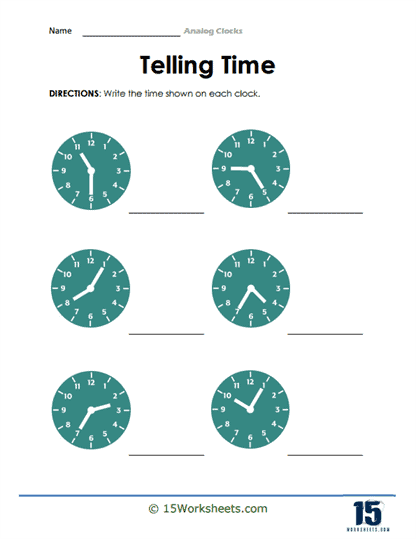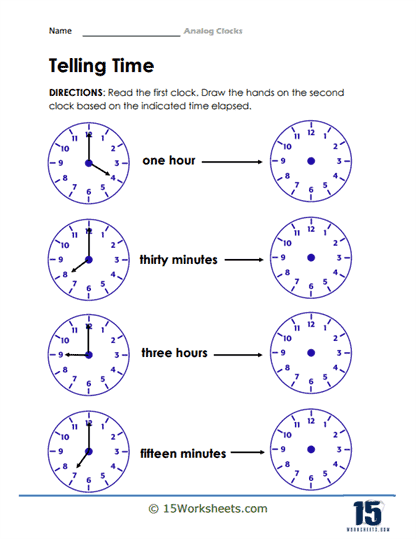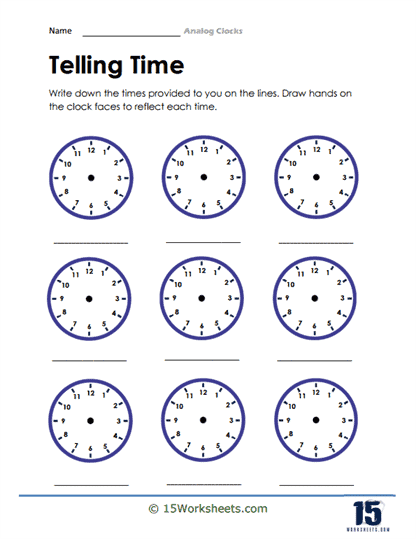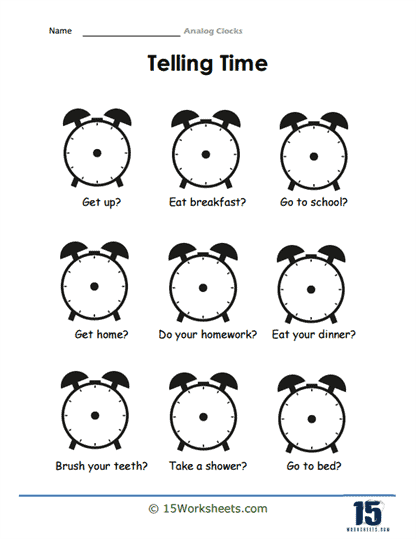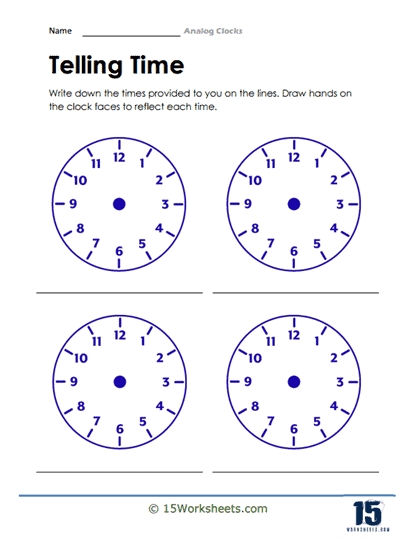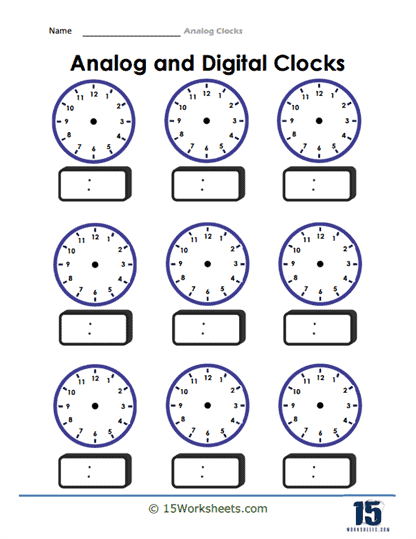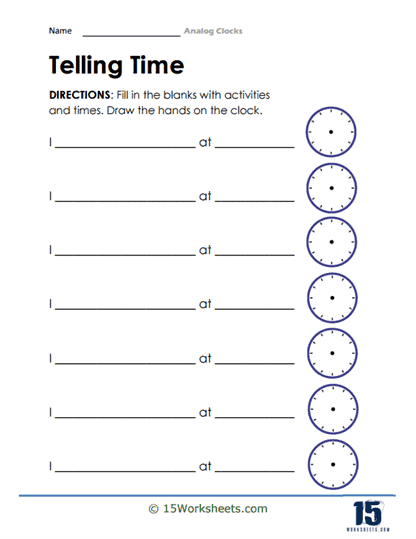Telling Time Worksheets
About These 15 Worksheets
Telling time worksheets are educational tools designed to help students learn how to read clocks and understand the concept of time. These worksheets typically feature a variety of clock faces, both analog and digital, and present tasks that require students to identify, record, or manipulate time. They are a staple in elementary education, where foundational math skills are developed, and they serve as an essential component of the broader mathematics curriculum.
The primary objective of telling time worksheets is to ensure that students can read and interpret clocks accurately. This involves recognizing the positions of the hour and minute hands on analog clocks and understanding the corresponding digital time. These worksheets also help students grasp the passage of time and develop skills related to time management and scheduling.
Mathematical Skills Explored
These worksheets begin with the most basic skill: the ability to read an analog clock. This involves recognizing the positions of the hour and minute hands and understanding how these positions correlate to specific times. Students learn to differentiate between the shorter hour hand and the longer minute hand, which is essential for accurately telling time.
One of the primary skills developed through these worksheets is an understanding of number sequencing and the concept of intervals. The numbers on a clock face range from 1 to 12, and students must understand how these numbers represent hours. Additionally, they learn that the minute hand moves in intervals of five, leading to a more nuanced comprehension of counting by fives. This reinforces their skip-counting skills, which are crucial for various mathematical operations.
Another significant skill honed through these worksheets is the ability to perform basic arithmetic operations such as addition and subtraction within the context of time. For example, students might be asked to determine what time it will be one hour or 30 minutes after a given time. This requires them to add or subtract time, thereby practicing their arithmetic skills. More complex problems might involve calculating the time before or after a certain duration, which introduces the concept of elapsed time and further develops their addition and subtraction abilities.
Understanding fractions and their application is another critical skill examined in telling time worksheets. The clock face is a perfect visual representation of fractions, as it is divided into 12 equal parts. Students learn to identify quarter past, half past, and quarter to the hour, translating these into 15, 30, and 45 minutes respectively. This understanding of fractions as parts of a whole hour helps students see the practical application of fractions in everyday life and reinforces their knowledge of this mathematical concept.
Benefits of These Worksheets
These worksheets offer numerous benefits to students, extending beyond mere time-telling skills. One of the most significant advantages is that they help students develop a solid understanding of time, which is essential for effective time management and scheduling. By practicing with these worksheets, students learn to allocate their time efficiently, a skill that is valuable in both academic and personal contexts.
These worksheets also enhance students’ mathematical abilities, particularly in the areas of arithmetic, unit conversion, and logical reasoning. They provide a practical application of math skills, making math more relevant and engaging for students. As a result, students are more likely to retain what they have learned and apply it in real-world situations.
They also encourage critical thinking and problem-solving. Students must assess various tasks, make comparisons, and draw conclusions based on their observations of clock faces and time calculations. This process helps develop their analytical skills and their ability to make informed decisions.
Real World Application Of This Skill
The skills developed through these worksheets are applied in various real-world scenarios every day, making them essential for effective functioning in personal, educational, and professional contexts.
Daily Scheduling and Time Management – One of the most direct applications is in daily scheduling and time management. Understanding how to read a clock enables individuals to plan their day, allocate time for different tasks, and adhere to schedules. For example, students use these skills to know when their classes start and end, manage homework time, and plan for extracurricular activities. Adults rely on time-telling skills to balance work commitments, personal appointments, and family responsibilities, ensuring that they can meet deadlines and maintain a structured routine.
Professional Contexts – In professional settings, the ability to tell time is crucial for productivity and efficiency. Employees use these skills to track working hours, schedule meetings, and manage project timelines. For instance, a project manager might need to coordinate team activities, set deadlines, and ensure that tasks are completed within the stipulated time frames. Healthcare professionals rely on precise time-telling to administer medications, schedule patient appointments, and monitor treatment durations. In the retail and service industries, staff must manage shift schedules, opening and closing times, and customer appointments accurately.
Travel and Transportation – Understanding time is vital for travel and transportation. Whether catching a bus, train, or flight, individuals need to be aware of departure and arrival times to plan their journeys effectively. This involves interpreting schedules that often use both 12-hour and 24-hour formats and calculating travel durations and connections. Accurate time-telling skills help prevent missed flights or trains and ensure smooth travel experiences. Furthermore, transport operators and logistics professionals use these skills to schedule services, coordinate routes, and ensure timely deliveries.
Event Planning and Coordination – Event planning and coordination heavily rely on the ability to manage time. Organizers need to schedule events, allocate time slots for different activities, and ensure that everything runs according to plan. For instance, planning a conference requires meticulous scheduling of sessions, breaks, and networking opportunities. Accurate time-telling ensures that events start and finish on time, maintaining a smooth flow and enhancing participant experience.
Cooking and Household Management – In everyday household management, telling time is essential for activities such as cooking and cleaning. Recipes often require precise timing for preparation and cooking steps, and being able to track time accurately ensures that meals are cooked properly. Time management skills also help in balancing household chores, such as knowing how long tasks will take and scheduling them efficiently within a day.

